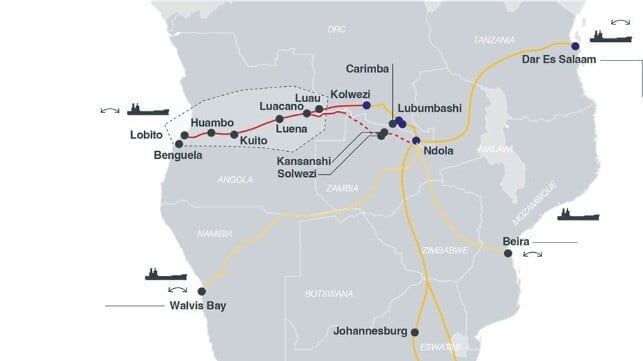U.S. and China Back Competing Rail Corridors to Zambia's Copper Belt

The U.S government has given new commitments in the development of the Lobito Corridor, which is proposed as a critical trade route to facilitate movement of green energy resources in the Southern Africa region. At a forum last week in Lusaka convened by the G7’s Partnership for Global Infrastructure and Investment (PGI), the U.S. International Development Finance Corporation (DFC) announced new financing support for the corridor, which extends across Angola, Zambia, and the Democratic Republic of Congo.
Speaking at the forum, DFC’s Deputy CEO Nisha Biswal revealed that her corporation’s board of directors had approved a new $250 million debt facility to the Africa Finance Corporation (AFC). This funding will support AFC as it invests in and strengthens infrastructure across the African continent. Currently, AFC is providing advisory support to Lobito Atlantic Railway(LAR) consortium, which is upgrading the 1,300km (807 miles) Benguela rail line across Angola.
With demand for copper and cobalt minerals rising with the growth of green energy, the Copper Belt region straddling Zambia and DRC has gained global recognition. However, major corporations are finding it hard to move the ores with limited transport options out of the Copper Belt. The conventional route to the Indian Ocean port of Durban in South Africa has become unreliable, characterized by perennial truck congestion of more than 30 miles at some border points.
The Lobito Corridor, which diverts to the Angolan Atlantic Port city of Lobito, is designed as an alternative route, halving the distance to Durban. In 2023, the corridor got a major backing when the U.S and EU signing a MoU with Angola, DRC and Zambia, which underscored a shared commitment to develop the corridor.
The Lobito corridor has existed for over a century, with the Benguela railway line the main carrier along the corridor. Belgium and Portugal constructed the tracks between 1902 and 1929, creating an important gateway for industrial and agricultural goods from Angola, DRC and Zambia.
However, the railway shut down in the mid-seventies when civil war broke out in Angola. Perpetual insecurity in DRC also led to suspension of the railway beyond the Angola border. As a consequence, Port of Lobito, which forms the gateway of the corridor, now handles a fraction of its peak capacity.
The U.S estimates that it would cost more than $1 billion to fully reconstruct the corridor. But besides rebuilding the infrastructure, the focus has also been on traders and mining companies to use the route. Last week, mining companies Trafigura and Kamoa-Kakula agreed to a long-term commitment with Lobito Railway authority to transport minerals along the corridor for a minimum of six years.
The support from Washington and Brussels to the Lobito Corridor has been interpreted as a geopolitical move, with China currently dominating supply chains for critical energy transition minerals. Linking the Copper Belt to the Atlantic Ocean will ensure the West keeps a stake in this important global value chain.

that matters most
Get the latest maritime news delivered to your inbox daily.
The geopolitical competition for control of the Copper Belt is palpable. As the West backs the Atlantic route, China is aiming for the Indian Ocean route. On Wednesday, China’s Ambassador to Zambia, Du Xiaohui, handed a proposal to Frank Tayali, the nation’s Transport Minister, detailing a plan to revamp the Tanzania-Zambia railway.
China proposes to spend more than $1 billion in refurbishing the railway, commonly known as Tazara, which connects Zambia’s Copper Belt with Tanzania’s Dar es Salaam Port. China built the 1156-mile railway in the 1970s but is currently out of service. The Tanzanian and Zambian governments have already agreed to hand a concession for the railway to a Chinese state-owned company, the China Civil Engineering Construction Corp.
